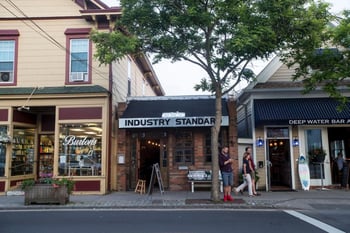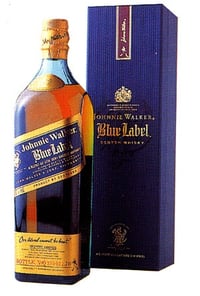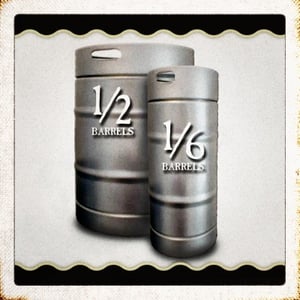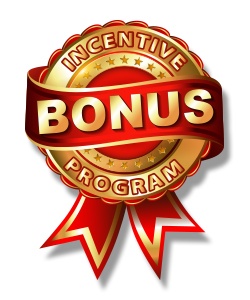At Bar-i, we adhere to a philosophy that we like to call “down to the serving” liquor inventory. We provide all of our clients with very precise data regarding the performance of every product sold at their bar in order to make recommendations that will maximize profitability. In order to obtain this level of accuracy with our data, we need to be able to provide results down to the individual serving. This is the only way to precisely compare what is sold vs. what is poured so that you know which products are underperforming.
By knowing exactly how much of every product is missing in a given inventory period, you can take the steps necessary to improve accountability and ensure that everything poured is also rung in. This down to the serving accuracy is one of the elements that distinguish Bar-i’s inventory services from many other options, and it’s one of the main reasons why we are able to help our clients reduce their liquor cost by 3% on average.
Since most liquor drinks are served in 1.5 oz. portions, your inventory system needs to be able to measure product on hand down to the ounce. Otherwise, you simply can’t achieve the actionable data necessary to evaluate the performance of each product being sold at your bar. When you implement a down to the serving liquor inventory system, you’ll experience a wide range of benefits that go beyond simply maximizing profits.
Down to the Serving Inventory Provides a Target to Aim For
 Most bars look at their liquor cost and just compare it to some notion of an industry standard. This is pointless. In reality, there is no such thing as an “industry standard bar.” While there are certainly performance averages, your bar isn’t an “average bar.” It is a unique entity and therefore what’s best for your bar can’t be determined by comparing it to the average in the industry. Instead, it has to be determined based on the specifics of your bar.
Most bars look at their liquor cost and just compare it to some notion of an industry standard. This is pointless. In reality, there is no such thing as an “industry standard bar.” While there are certainly performance averages, your bar isn’t an “average bar.” It is a unique entity and therefore what’s best for your bar can’t be determined by comparing it to the average in the industry. Instead, it has to be determined based on the specifics of your bar.
In addition, comparing results to past performances builds in losses to your expectations. We know that there is product missing at all bars. This is simply a reality of the industry. Not every single drink is poured correctly and not every drink is rung in. If you base your expectations on what you’ve done in the past, you’re building those deficiencies into your expectations, making it harder to identify an accurate target performance level to strive for.
Bar-i is able to provide you with an achievable liquor cost. This figure is somewhat unique to Bar-i and is made possible by our down to the serving accuracy. Achievable liquor cost tells you what your liquor cost would be if there was no product missing at all. It’s very customized to your bar because it considers a variety of unique elements associated with your business such as:
- Your cost when purchasing alcohol products from distributors
- The price you set for every drink you sell
- The effect of discounting (comps, shift drinks, Happy Hour prices, and other nightly drink specials)
- Product mix, including the changes to the products you sell over time
- The effect of tax
Rather than compare your results to a general standard, we are able to use this achievable liquor cost figure to create a specific comparison that factors in real life elements at play at your bar.
You Have the Ability to Verify Individual Pour Sizes
It’s important to ensure all drinks are poured accurately for two reasons:
- Drinks that are poured heavy will erode your profit margin over time
- Drinks poured inconsistently will taste different depending on who is making the drink
By using an inventory system with down to the serving accuracy, you’ll be able to ensure that all drinks are being poured correctly. Let’s examine how this works with a few real world examples:
 High end, low sales volume products – High end products such as Johnny Walker Blue typically have a low sales volume due to their price. If you’re using a tenthing method to measure the amount of product in the bottle, it’s very difficult to determine whether the Johnny Walker Blue drinks being served were actually rung in. When you’re dealing with a 1.5 oz. portion for a low volume product that’s only served once or twice a week, tenthing doesn’t give you accurate enough information to track performance.
High end, low sales volume products – High end products such as Johnny Walker Blue typically have a low sales volume due to their price. If you’re using a tenthing method to measure the amount of product in the bottle, it’s very difficult to determine whether the Johnny Walker Blue drinks being served were actually rung in. When you’re dealing with a 1.5 oz. portion for a low volume product that’s only served once or twice a week, tenthing doesn’t give you accurate enough information to track performance.
With a down to the serving inventory system, you can actually see the size of individual pours. This is especially true for high end, low volume products. You’ll be able to tell wither your bartenders are accurately pouring 1.5 oz. servings or if their pours are a little heavy or light. This allows you to provide your bartenders with feedback regarding the accuracy of their pours, ensuring that this aspect of their job performance improves over time.- Wines by the glass – If you’re aiming for a 6 oz. pour, you can see whether your bartenders are actually pouring glasses of wine accurately and correctly. Without down to the serving data, you can’t evaluate performance in a way that provides actionable information.
- Low end, high sales volume products – For most bars, their best selling liquor product is well vodka. When you look at the yield of your well vodka, you will have data regarding how accurately it’s being poured and how much is being given away. It’s extremely difficult to obtain this information for high volume products that are served hundreds of times a week without down to the serving accuracy.
It’s Easier to Determine Keg Yields
 It’s much trickier to evaluate the performance of draft beer products than bottled beer products because with draft beer, there is some waste built into our expectations. This is due to the fact that a certain amount of beer is always left in the kegs and a little bit of foaming is inevitable when you’re serving keg beer. This foaming occurs even when you have a good draft beer system at your bar.
It’s much trickier to evaluate the performance of draft beer products than bottled beer products because with draft beer, there is some waste built into our expectations. This is due to the fact that a certain amount of beer is always left in the kegs and a little bit of foaming is inevitable when you’re serving keg beer. This foaming occurs even when you have a good draft beer system at your bar.
When determining your keg yields, you should always consider the following factors:
- Typical keg yield should be above 95% -- Line cleaning and wastage should be less than 5% of usage.
- You need to account for giveaways – Not all performance issues are related to this built-in keg waste and the performance of your draft beer system.
- 25% difference in keg yields from sixtel kegs – One of our clients had a low overall keg yield. We were able to drill down using our down to the serving data to determine that there was a significant difference in the keg yield of sixtel kegs compared with half barrel kegs. You should consider this difference in performance when you decide which draft beer products to serve at your bar.
Down to the serving inventory systems can ensure that your keg yield is at or above this 95% standard since you will be able to evaluate the performance of each individual draft beer product in order to determine the cause of your problems. Consider the following example:
One of our clients was consistently struggling to get good pours from their draft IPA. It kept foaming up. Bar-i was able to determine that the problem was in the line. By switching the line for the IPA with the line for their cider (a significantly less foamy product), the bar was able to correct the problem and improve the performance of their IPA without spending any money. The information needed to make that correction wouldn’t have been available without down to the serving data.
You can Improve Consistency through Feedback
This level of accuracy forces us to develop standards and agree on a “right way” to do things as a group. When Bar-i sets up your inventory system, we write recipes for every drink sold at your bar. This process results in a discussion regarding standard pour sizes and the way each drink is poured (i.e. how many ounces of each ingredient are being used).
This discussion allows you to establish a correct way to do things, which creates greater consistency in the way your drinks taste regardless of which bartender pours it. This consistency enables you to set and meet expectations for your customers. When customers come to your bar, they always know how their desired drink will taste since it’s poured the same exact way every time.
You Receive Actionable Information that will Improve Performance
All bars know products are missing, but when you calculate liquor cost by category instead of by product, you don’t know how much is missing for each individual product. Bar-i’s down to the serving accuracy allows you to know exactly what’s missing. This often tells us why a product is missing and how to fix it.
For example, if liquor is missing across the board in proportion to sales, it’s likely due to drinks being poured incorrectly. However, if you’re missing significant quantities of 1 or 2 products such as Jägermeister, it’s likely because shots are being given away. This ability to generate data that you can act on to improve performance is crucial to increasing your profitability.
On average, most Bar-i clients experience a 3% improvement in their liquor cost due to this actionable accountability data. This would translate to $14,000 in direct savings based on $40,000 per month in sales, which is a relatively moderate sales volume. In general, Bar-i’s down to the serving inventory system starts to make financial sense for bars that generate at least $20,000 in sales per month.
This Data can Be Used to Create Incentives for Your Staff
 It’s a good idea to build incentives into your system in order to improve the performance of your bar staff. Bar-i recommends having a tiered incentive program where perks such as shift drinks and comp tabs are linked to performance. Having an accountability based system with down to the serving accuracy provides the objective, verifiable data to base your incentive program on.
It’s a good idea to build incentives into your system in order to improve the performance of your bar staff. Bar-i recommends having a tiered incentive program where perks such as shift drinks and comp tabs are linked to performance. Having an accountability based system with down to the serving accuracy provides the objective, verifiable data to base your incentive program on.
You will also be able to link incentive rewards to the actual value created by the improved performance of your bar staff. You can apply the 5:1 rule which states that 5% shrinkage will increase your liquor cost by 1%. You can then create a budget for the rewards you’re providing your staff depending on how well performance improves.
Down to the Serving Inventory is More than Just Fancy Software
When evaluating potential inventory system upgrades, don’t just think about what the software can do. You also need to think about how it can be applied to your circumstances. Some systems are just providing you with sophisticated software. However, the nuances of how you use this software will significantly impact the value you get from your inventory efforts.
When you work with Bar-i, you will have a dedicated account manager helping you to spot trends and making recommendations for how you can improve your bar’s processes to maximize profits. This ensures that you get the most out of the benefits provided by our down to the serving inventory system.
If you would like to learn more about how Bar-i’s inventory system can help you improve your bar’s performance and maximize profits, please contact us today to schedule a free consultation. We serve bars nationwide from our offices in Denver, Colorado.


-1.png)